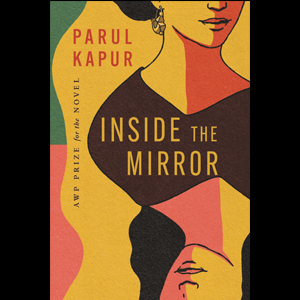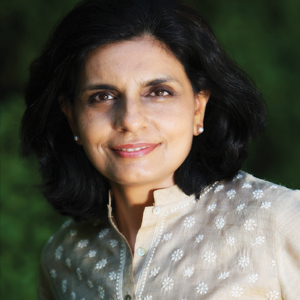Books: A Tale of Twin Sisters

This debut novel, which won the 2022 AWP (Association of Writers and Writing Programs) Prize for the Novel, drew on Atlantan Parul Kapur’s experiences as a journalist in 1980s Bombay, where she’d reported on cultural events, and on the art and dance classes she’d taken as a college student in the U.S.
Partition. Independence. For South Asians of a certain generation, the words conjure up memories, both rich and painful, of shared histories cleaved apart, families alienated, intergenerational trauma—but also resurgence, pride, joy, and hope. Inside the Mirror (University of Nebraska Press) is a touching story about the lives of twin sisters Jaya and Kamlesh Malhotra, who come of age in 1950s Bombay (now Mumbai), and
of a family living through the pains of a post-colonial, independent, and partitioned India.
Jaya, a medical student, and Kamlesh, a trainee teacher, struggle against familial orthodoxy and expectations to pursue their true passions: painting and classical dance, respectively. The twins’ parents and grandmother Bebeji are a vital influence in their lives, and they’re urged to follow a path that’s in keeping with extant cultural mores and customs.
The writing comes alive in the descriptions of Jaya’s and Kamlesh’s artistic endeavors, with the details of both art forms rendered precisely and painstakingly. The reader in effect gets a master class in art appreciation—and gains an appreciation of its contested practice by young women in post-colonial India straining against class, status, and social norms.
Inside the Mirror is also meticulous in its attention to historical artifacts. The Bombay of the 1950s— with its tram cars, Irani cafés, progressive art exhibitions, and jostling crowds—plays a central role, showing us a city that has already established itself as a modern metropolis.
Constructing a story that revolves around the lives of twins is clever, allowing the author to explore emotions, idiosyncrasies, and ideas in subtly different ways. Kapur has done it deftly, showing how painter Jaya is studying to be a physician and dancer Kamlesh is training to be a teacher. Both are respectable, white-collar professions for young women from a reputable family, but the sisters don’t let go of their artistic passions, incurring the wrath of their elders and society. Jaya moves out of her home to live with her mentor, and Kamlesh pursues her dream of performing on stage and in a Hindi film.
Kapur’s writing is lyrical, fluid, and the phrasing stunningly beautiful in its starkness, as when she describes the living conditions of children in a slum that Jaya and Kamlesh visit: “The earth was all the people had for their needs—a vessel for their waste, a bed for their bodies. Its fine red powder dusted their skin and hair.”
Bebeji, the twins’ grandmother, emerges as a memorable character, as does Sringara, Jaya’s mentor. While the plot of the novel centers on the twins, Kapur fills out the background of the plot in rich detail, giving the reader a glimpse of the class- and caste-based inequality and inequity that characterizes Indian society. The reader may at times find the luscious details in the back stories heavy going. The pacing may get in the way of reaching the story’s denouement, but it’s a minor offkey note in an otherwise virtuosic performance by the author. While Inside the Mirror is set in a specific place and period, the themes explored are universal and still valid. At heart, the novel is about young women finding their true identities and fighting all odds to stay true to their sense of self.
Girija Sankar, a freelance writer based in the Atlanta metro area, works in global health.
AN INTERVIEW WITH PARUL KAPUR
By Girija Sankar
 You have captured the artistic endeavors of the twins in such great detail. Did you practice these art forms? How did you go about researching them?
You have captured the artistic endeavors of the twins in such great detail. Did you practice these art forms? How did you go about researching them?
I became very interested in painting, especially my junior year of college here. After my junior year, I went to London and started going to museums. That was eye-opening. Later, I transferred to Wesleyan University and started taking drawing classes. There was an American woman there who was studying Indian dance with Balasaraswati in Madras [now Chennai]. She came back to Wesleyan just as I arrived on campus, so I took one semester of Bharatanatyam with her. The other exposure that I had to Indian dance was through a friend in India who was an Odissi dancer. She taught me about the relationship a dancer had with their guru.
Photo: Vino Wong
The book project started more than 30 years ago. So, some of the experiences I had were still very fresh experiences in my mind. In fact, that is why I even thought of making one sister [a character in the novel] a dancer, because I thought, ‘Oh, I like dance. I have studied dance.’
How long did it take you to finish the book? You have mentioned that the project has been over 30 years in the making. How was your journey from writing to publication?
My journey started with the MFA program at Columbia. After getting my undergrad degree, I worked in India for a year at Bombay magazine, a city magazine with a young staff. When I came back to Columbia, I started writing short stories. I had also been thinking of doing something with this experience in India. First, I thought I would author a funny novel about a young team at a city magazine. I started with that but then decided that I would make it about multiple generations. It was going to be a novel that covered 25-30 years. As I started writing it, I realized that I did not have the skills I needed to do this enormous book. I pared it down to the story of the twin sisters, and I worked on it steadily from 1987 for about 18 years.
I then moved to Europe for a decade, but always found people that I could interview [for the novel]. Eventually, I sent out the manuscript to about nine agents. In the early 2000s, the infrastructure that writers have now did not exist. I was floundering and did not know how to revise it. When I hit the 25-year mark, I put it aside and started work on a second and third novel. Then, by chance, Deepa Mehta came to Atlanta, and I interviewed her for the books page at Arts ATL. She read my novel and gave me good notes on it. Two or three years ago, I noticed that some of my friends were entering literary contests, so I submitted the novel to AWP in 2022. When I won that contest, they partnered me with the University of Nebraska Press. The 30-plus years to publication was discouraging, of course, but I never lost faith in my book. I believe that is what helped me bring it to publication.
Based on this experience with your novel, how would you advise aspiring writers?
Writing it is a very private process. Nobody can sit down with you at your computer—that is something you have to do on your own. But after the initial stage, I would encourage writers to take advantage of the various resources such as writing groups and workshops. There is the Atlanta Writers Club, for example. Maybe you could find a group that is good for you.
While working on my third novel, I joined a group called Zona Rosa. It was an incredibly positive group, and exactly what I needed. If you are serious about getting your manuscript ready for an agent, you might have to invest several thousand dollars in an editor. Just as you would need money to open a shop or a restaurant, do not be afraid to put your money into it if you are at a certain point and you think that all you need is one good edit.
My advice to aspiring writers would be to write with integrity—and write a story about characters you care deeply about, because then you will have faith in your work and that faith can sometimes help you achieve the impossible.
Enjoyed reading Khabar magazine? Subscribe to Khabar and get a full digital copy of this Indian-American community magazine.
blog comments powered by Disqus












